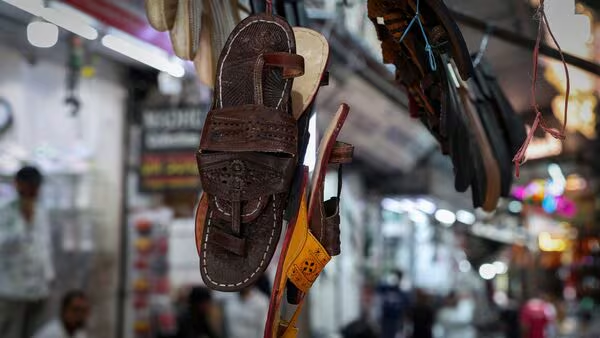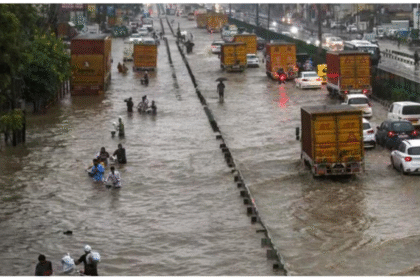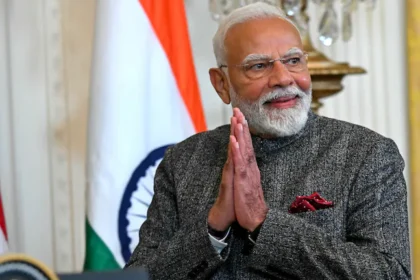India–UK Free Trade Agreement Set to Transform Leather and Footwear Exports
The signing of the long-anticipated India–UK Free Trade Agreement (FTA) marks a pivotal moment in India’s evolving global trade ambitions—particularly for sectors that have long operated beneath their full export potential. Among these, the leather and footwear industry stands as a clear beneficiary, now positioned to ride a wave of reduced tariffs, regulatory easing, and access to one of the most lucrative Western markets. Industry leaders and policymakers alike are now projecting a significant boom in exports, with forecasts estimating shipments could exceed $900 million in the near future.
This isn’t merely a trade policy footnote; it’s a structural shift that could redefine how India’s leather and footwear sector integrates with global value chains. For decades, Indian leather exporters have faced stiff competition from countries like Vietnam, Bangladesh, and China, often struggling against steep tariffs, fragmented production ecosystems, and limited market penetration in high-income nations. The India–UK FTA promises to disrupt that pattern—with the UK emerging as both a trade partner and a gateway to broader European opportunities.
Why the UK Market Matters
The United Kingdom has consistently remained one of the top five global importers of leather goods and footwear. Its market—known for high consumer spending on fashion, heritage brands, and a strong e-commerce culture—offers Indian exporters a unique intersection of traditional retail and digital retail expansion.
Before the FTA, Indian leather products attracted import duties as high as 8% to 10%, significantly undermining their price competitiveness against European or Southeast Asian alternatives. With these duties set to be either eliminated or drastically reduced, Indian products—ranging from finished leather shoes to designer handbags and accessories—can now be priced far more competitively, potentially increasing demand and market share rapidly.
Moreover, unlike the U.S. or EU blocs, the UK is currently seeking strong post-Brexit bilateral trade partnerships. This gives India a golden opportunity to establish favorable trade precedents and long-term export frameworks with a mature, high-value market.
Government Push Meets Industry Readiness
The announcement of this strategic trade agreement comes at a time when the Indian government is already investing heavily in manufacturing, with particular focus on labor-intensive industries like leather and textiles. Under the Production Linked Incentive (PLI) schemes, and the Make in India initiative, the Centre has incentivized quality upgrades, compliance with global sustainability norms, and capacity expansions for leather goods producers.
According to CLE (Council for Leather Exports) Chairman Sanjay Leekha, the FTA could lead to a 60% to 80% rise in exports to the UK in the next 2-3 years if properly leveraged. Speaking at a recent trade summit, Leekha said:
“India’s leather and footwear industry is poised to scale new heights, and the FTA with the UK couldn’t have come at a better time. With tariff barriers gone, we expect not just growth in numbers, but also value-added product exports to dominate.”
The government has echoed these sentiments. Commerce and Industry Minister Piyush Goyal, one of the key negotiators of the FTA, described the deal as a “win-win for traditional sectors and emerging industries alike.”
Opportunities for MSMEs and Artisans
One of the most promising aspects of this FTA is its potential impact on India’s micro, small, and medium enterprises (MSMEs)—particularly those based in traditional leather hubs such as Kanpur, Agra, Chennai, Ranipet, and Kolkata. Many of these family-run businesses and artisan clusters produce premium handmade leather goods, but face scalability issues due to compliance costs, supply chain limitations, and limited foreign market access.
With the UK deal potentially easing rules of origin, customs procedures, and product certification protocols, these MSMEs could find it significantly easier to reach British retailers directly or via digital platforms. This move may also encourage more MSME players to adopt global quality standards, bringing long-term structural benefits to the sector.
E-commerce platforms in the UK—especially luxury and lifestyle marketplaces—could also offer Indian manufacturers direct-to-consumer opportunities, bypassing middlemen and increasing profit margins.
As the finer details of the India–UK Free Trade Agreement (FTA) begin to unfold, clarity is emerging around its real economic value—not just as a symbolic geopolitical partnership, but as a measurable, market-access-driven opportunity for India’s long-struggling but high-potential leather and footwear industry. At the heart of this optimism lies one hard-hitting factor: tariff elimination.
For decades, Indian leather exporters have operated with a pricing disadvantage in the UK market. From finished leather shoes and handcrafted boots to travel bags, wallets, and belts, most Indian products faced import duties ranging from 8% to 12% in the British market. These costs were often the difference between winning a contract or losing out to competitors from Vietnam, China, or even Turkey, who benefited from earlier trade alignments or regional advantages.
What the FTA Offers: A Clean Slate on Tariffs
The India–UK FTA is now poised to erase that competitive imbalance. In its current form, the agreement proposes immediate or phased removal of customs duties on more than 80% of tariff lines related to Indian leather and leather-based goods. This will not only reduce end-consumer prices in the UK but also offer higher margins to Indian exporters—either to reinvest in quality upgrades or scale up operations.
The Council for Leather Exports (CLE) anticipates that leather footwear—India’s most valuable sub-sector within leather—will be among the top three export gainers. In 2023, India’s leather footwear exports stood at around $500 million. With the new tariff regime and market momentum, that number could cross $900 million within 24 months.
Says Rajeev Bansal, a senior analyst with CRISIL:
“The removal of even a 10% tariff has cascading benefits. From product pricing to contract volume to retailer confidence, Indian exporters suddenly become viable alternatives to longstanding partners like Vietnam.”
India’s Edge Over Competitors: More Than Just Price
The FTA is not happening in a vacuum. Timing is key. With UK–EU trade ties still adjusting post-Brexit, and with Chinese imports increasingly viewed through a lens of political caution, India now has a clear opportunity to step up not just as a supplier—but as a partner of choice.
Key Advantages Over Regional Rivals:
- Diverse Production Ecosystem: India has a robust domestic supply of raw hides, tanneries, and skilled labor concentrated in regions like Tamil Nadu and Uttar Pradesh.
- Heritage Craftsmanship: Unlike factory-produced bulk exports from China, India offers hand-stitched, artisanal craftsmanship that aligns with UK’s premium retail market.
- Stable Political Environment: Trade confidence is higher with democratic, policy-stable nations.
- Sustainability Push: India’s exporters are increasingly aligning with global ESG (Environmental, Social, Governance) norms—offering clean leather processing, eco-friendly tanning, and ethical labor compliance.
Indian exporters now have the chance to out-brand and out-position competitors, not just out-price them.
How Exporters Are Preparing: Capacity, Compliance, and Contracts
With interest peaking, exporters across India’s leather belts are already making internal adjustments. In Agra and Kanpur, factories are reportedly hiring seasonal labor and upgrading machinery to meet stricter European compliance norms. In Chennai, several mid-sized leather units have applied for ISO and BSCI certifications, required by most UK and European retail chains.
The CLE is also coordinating training workshops, logistics support, and market entry briefings to ensure smaller exporters are not left behind. Exporters are being advised to:
- Recalibrate product catalogues to suit British consumer preferences (e.g., eco-leather, vegan blends, sustainable packaging).
- Register with major British e-commerce platforms for D2C sales.
- Engage UK-based trade representatives for on-ground buyer access.
Early signs suggest the industry is responding swiftly. Already, trade bodies have noted a 22% uptick in pre-orders from UK-based retailers for the upcoming fiscal year, particularly in leather footwear, fashion accessories, and office travel bags.
UK Buyer Sentiment: Expectations Beyond Price
But success won’t depend on tariffs alone. British retailers—and UK consumers—are increasingly driven by sustainability, traceability, and ethical sourcing. Indian exporters must now ensure that their supply chains are transparent and compliant with:
- Environmental norms: Use of chrome-free tanning, water recycling, and solar-powered production.
- Labor standards: Adherence to minimum wage laws, safe working conditions, and zero child labor.
- Packaging requirements: Recyclable, minimalistic packaging with carbon footprint disclosures.
Many retailers in the UK, such as Marks & Spencer, Next, and ASOS, already follow stringent ESG checklists. For Indian leather producers looking to enter long-term contracts, aligning with these values isn’t just an option—it’s essential.
In fact, a new breed of Indian exporters is emerging—young, digitally savvy entrepreneurs combining heritage skills with tech-enabled transparency. Their approach reflects what the UK market wants: affordable luxury with a conscience.
The numbers tell one story—but the streets of Kanpur, Ranipet, Agra, and Kolkata are narrating another. In the aftermath of the India–UK Free Trade Agreement, India’s leather and footwear exporters are doing more than upgrading balance sheets—they are reviving forgotten crafts, empowering artisan communities, and slowly building what could become the next global identity: Brand India Leather.
What began as a macroeconomic policy decision is now transforming into a grassroots movement. Across India’s leather clusters, anticipation is morphing into action—and action into results.
Kanpur’s Resurgence: From Decline to Rebirth
Once considered the “Manchester of the East,” Kanpur was the beating heart of India’s leather trade in the early 20th century. Over time, pollution crackdowns, lack of innovation, and global competition dimmed its shine. But post-FTA, the city is experiencing a renaissance.
Take the story of Shaan Leathers, a third-generation Kanpur-based manufacturer whose factory had downsized to 20% of its pre-pandemic capacity. “We were barely surviving,” says owner Salman Qureshi, who once employed 150 artisans. “But now, with the UK market opening up, we’ve already received expressions of interest from two British retailers. We’ve rehired 40 workers this month alone.”
Salman’s is not an isolated case. According to the Kanpur Leather Cluster Development Association, over 60 small-to-mid-sized exporters in the region have revived dormant operations in anticipation of increased UK orders.
Government support has added fuel to this revival. With the Uttar Pradesh Industrial Development Authority offering interest subsidies on machinery and compliance certification reimbursements, exporters are upgrading production lines, revamping inventory models, and most importantly—bringing skilled labor back to the shop floor.
Ranipet and Chennai: Modernizing Heritage
In Tamil Nadu, Ranipet, Ambur, and Vaniyambadi—regions famed for their high-quality tanneries—are accelerating their modern makeover. While these towns never truly collapsed like some northern clusters, the FTA is now pushing them toward a more premium, design-first identity.
At the heart of this transformation is Flora Fashions, a Chennai-based exporter known for high-end leather accessories. Founder R. Divya, a second-generation entrepreneur, has partnered with British design houses to co-create exclusive lines for the post-FTA launch.
“For decades, we exported plain black and brown belts to wholesalers. But today’s UK market wants story-driven products—craftsmanship, sustainability, and finish. The FTA gives us the cost competitiveness. Now, we must match it with creativity,” says Divya.
She’s now working with local design students and Italian consultants to build a fusion design lab, integrating South Indian traditional motifs with contemporary British tastes. For many exporters like her, FTA is not just about more exports—but better exports.
Empowering India’s Artisans: A Socio-Economic Upswing
Perhaps the most meaningful impact of the India–UK FTA lies beyond spreadsheets—in the lives of the 4.42 million Indians employed directly or indirectly by the leather industry.
India’s leather sector is one of the most labor-intensive industries, heavily reliant on artisans, hand-stitchers, tanners, dye workers, and small-scale designers. In towns like Shantiniketan (West Bengal) and Dharavi (Mumbai), thousands of artisans have passed down leatherworking skills across generations. Many had begun to abandon the craft for urban daily-wage jobs.
But with export prospects rising, local entrepreneurs are reaching back to artisan communities, offering better wages, flexible hours, and—most crucially—dignity of skilled labor.
In Kolkata, cooperative models like Utsaah Collective are enabling women leatherworkers to manufacture UK-bound fashion accessories under fair trade conditions. Founder Neha Moitra explains:
“We always had the skill, but we lacked the channels. Now with British demand growing and buyers asking for ‘ethically sourced goods,’ our artisans are finally at the center of the story.”
The Branding of Indian Leather: Next Stop, Global Premium
India has long been the second-largest exporter of leather garments globally. Yet, it has often lagged in brand visibility compared to Italy, France, or even Vietnam. The India–UK FTA now provides the perfect opportunity for India to reposition itself—not just as a backend supplier, but a premium brand creator.
The Council for Leather Exports (CLE) has already launched a new global branding campaign titled “India: Leather with a Legacy.” Backed by the Ministry of Commerce and Industry, this initiative aims to:
- Position India as a source of heritage + innovation.
- Promote GI-tagged leather crafts from specific regions.
- Push Indian leather brands into global fashion expos, particularly in London, Paris, and Milan.
- Facilitate design collaborations between Indian exporters and British design schools.
If the campaign gains traction, Indian leather goods might soon be featured not just in wholesale warehouses—but on shelves at Harrods, Selfridges, and Liberty London.
Real Challenges Remain: Logistics, Compliance, and Tech Gaps
However, the path is not without its hurdles. Several exporters still face logistics bottlenecks, including shipping delays, documentation errors, and poor last-mile connectivity. The UK’s complex post-Brexit customs regime can be a minefield for new exporters who lack digital tracking systems.
Moreover, compliance documentation—including REACH certifications, ESG disclosures, and product traceability—remains a barrier for many MSMEs, particularly in eastern India and remote towns.
To tackle this, the Export Credit Guarantee Corporation (ECGC) and DGFT (Directorate General of Foreign Trade) are rolling out advisory support, export training modules, and tech toolkits for small exporters.
The India–UK Free Trade Agreement has opened more than just customs channels—it has sparked a movement toward modernisation, sustainability, and reputation building. As Indian exporters recalibrate for global standards, three key trends are defining the sector’s next evolution: digital trade enablement, eco-conscious manufacturing, and a new rapport with the UK buyer ecosystem.
This part investigates the strategic shift from analog trade systems to digital documentation, the emergence of vegan and eco-leather exports, and how British brands are increasingly looking to India for more than just cost-effective procurement.
🌐 1. Digital Transformation in Trade: From Paper to Portal
Indian leather and footwear exporters—many of whom previously relied on traditional paper trails for trade—are now pivoting toward digitally enabled compliance, tracking, and certifications. The FTA, by streamlining tariffs and enabling smoother cross-border operations, has also catalysed a demand for real-time logistics visibility and end-to-end traceability.
Key shifts include:
- Digital Document Exchange: Exporters are adopting DGFT’s eBRC system, ICEGATE integration, and blockchain-based trade records to speed up documentation and improve transparency.
- QR-coded Traceability Tags: Large footwear exporters like Liberty Shoes and Mirza International are deploying scannable tags that track products from tannery to retail store, a feature highly appreciated by British importers.
- Export Readiness Platforms: Organisations like India Trade Portal and FIEO (Federation of Indian Export Organisations) are conducting digital upskilling bootcamps for first-time exporters and MSMEs.
This digital shift isn’t just a convenience—it’s a requirement. UK buyers are increasingly demanding digitised audit trails for proof of ethical sourcing and sustainable practices.
🌱 2. Greening the Leather: Vegan Leather, Chrome-Free Tanning & Circular Economy
Today’s British consumer isn’t just price-conscious—they’re ethically driven, eco-aware, and transparency-obsessed. This presents a major opportunity—and challenge—for India’s leather exporters.
The Green Shift:
- Vegan Leather Exports: Startups like Malai Biomaterials (Kerala) and Phool.co (Uttar Pradesh) are leading the charge in plant-based leather substitutes made from coconut waste, banana fibers, and temple flower discards.
- Chrome-Free and Vegetable Tanning: Tanneries in Tamil Nadu, notably in Vellore and Dindigul, are investing in natural dyeing and chrome-free tanning techniques that reduce environmental toxicity.
- Zero-Liquid Discharge (ZLD) Units: With stricter UK sustainability norms, Indian exporters are investing in ZLD-compliant effluent treatment plants, especially in regions like Jajmau and Unnao.
The Leather Export Promotion Council (LEPC) has now made ESG certification a priority metric for international promotion, encouraging industry-wide audits.
🛍️ 3. Inside the UK Buyer’s Mind: What British Retailers Want
Indian exporters no longer just compete on price. In the UK—post-Brexit and post-COVID—the procurement strategy has changed dramatically. Buyers are now looking east for long-term, agile, and sustainable sourcing partners.
Insights from London:
- Ethical & Transparent Sourcing: Buyers like Marks & Spencer, Clarks, and John Lewis are placing ESG (Environmental, Social & Governance) compliance at the center of vendor selection.
- Shorter Lead Times: Fast fashion cycles in the UK require exporters to shift from 90-day fulfilments to 30–45 day windows, necessitating faster production and digital coordination.
- Private Label Co-Creation: UK brands increasingly want Indian exporters to design and manufacture under their own private labels, not just serve as white-label vendors.
- Diversity & Storytelling: Handcrafted narratives, regional crafts, and woman-led cooperatives appeal to UK niche retailers who are marketing to conscious Gen Z buyers.
A recent UK-India Business Council (UKIBC) report highlights that 47% of UK retailers surveyed in Q1 2025 listed India as their preferred footwear sourcing destination—ahead of Vietnam and even China, citing “favorable tariff structure, transparency, and skilled handcrafting tradition.”
🏆 4. Projecting the Future: Can India Challenge Italy in Luxury Leather?
While Italy, France, and Spain continue to dominate luxury leather markets, India is strategically positioning itself as a value-premium alternative—where quality meets scale.
Where India Can Lead:
- Luxury Mass Customisation: Offering semi-premium products with customisation (e.g., initials, one-of-a-kind texture work) at a lower cost than Europe.
- Handcrafted Heritage: Leveraging regional GI-tagged crafts like Shantiniketan leather embossing or Kolhapuri stitching to appeal to buyers seeking authenticity.
- Government Support: With PLI schemes, cluster funding, and EXIM Bank soft loans, the Indian government is backing leather exports as part of its “Make in India for the World” vision.
However, to challenge Italy, India must:
- Improve brand visibility globally.
- Invest in high-end product design and packaging.
- Create luxury leather training institutes akin to what Italy has done with Scuola del Cuoio (Florence).
📈 What’s Next?
As UK markets open wider and Indian businesses evolve faster, the synergy is becoming evident. What once was a supplier-client dynamic is fast turning into a co-creation ecosystem where Indian manufacturers, British retailers, and global consumers are aligned by values—sustainability, authenticity, and innovation.
Also Read : Supreme Court Says 7/11 Acquittals by Bombay High Court Cannot Be Treated as Precedent Yet








